Revolutionary Tennis |
||
Tennis Instruction That Makes Sense |
||
”TONTERĶAS! "TOP TEN TENNIS MYTHS" by Vic Braden August 7, 2001, www.tennisweek.com [photos are mine, plus red type inserts] "Myth Seven: Scratch Your Back And Reach Up To Hit Your Serve
"In the early 1960's, I talked Dodger baseball pitcher, Don Drysdale, into being a subject in a research project. I wanted to see how much information a student could take before "information overload" entered the picture. The deal was that we would film the entire lesson and he would stay on the court for eight hours. We would then discuss what he had learned at dinner. The eight hour lesson took it's toll as Don fell asleep at the restaurant table, and I didn't get everything on tape. I especially wanted to discuss the blazing speed Don had on his serve when I suggested he try to use the same motion when serving that he used on the mound. Later, while viewing the film for the 20th time, I discovered something about the serve that has helped me teach young students to achieve great speed.
"Just to make sure that the better servers didn't scratch their backs [the genesis of his misbelief], I filmed six top players on the professional circuit. The group included Arthur Ashe, Rod Laver and Chris Evert. I placed one camera on the ground and one 32 feet above the servers. The high camera clearly showed the players that their racquet was traveling away from the body rather than scratching the back during the serve [scratch up on the serve]. Arthur Ashe, after viewing the film, said, "My God, I don't do at all what I thought I was doing." [I doubt very much Ashe thought he scratched his back on the way up with the racket. He probably thought it traveled literally straight up, that is the forearm lifted straight instead of in a rotational manner around the biceps, and that was the relevance of his comment]. "The bottom line is, if you're not getting much speed on your serve, stop scratching your back with the racquet and pointing the elbow of your hitting arm up to the sky." END. Vic acknowledges in his book (Tennis for The Future) the racket "falls to the small of your back," but he does not consider it the back scratch point of the serve. The back scratch point for him is when the racket is ON THE WAY UP to hit the ball, and he points out the forearm and hand don't literally go straight up right next to your head. Instead there is a slight looping motion of the forearm out away from and behind the body when you swing the racket up to hit the ball. Hence he calls the backscratch position "a myth."
I was taught to drop the racket down behind my back and bring it straight up to the ball, butt cap first, to hit the snot out of it. I wasn't told to swing the racket out away from my back to the back fence when swinging up, and I wasn't made aware of the fact this happened. If I had been it wouldn't have made any difference, trying to do something about that specifically would mean my racket would be traveling on a horizontal plane out away from my body instead of a vertical one up to the ball and my serve would have suffered. I never, ever, would have thought to bring my racket out away from my back. The racket will go back on that horizontal plane briefly, similar to a pitching motion, due to events that have preceded it (the use of the shoulders and chest muscles, upcoming in the last section). The fact some tennis players were unaware of this normal thrower's movement of the racket arm when swinging up until Vic's filmed experiment pointed it out is noteworthy and he deserves credit for it. But why go around shouting, "the back scratch is a myth, the backscratch is a myth!" instead of instructing on what he found, regardless of the backscratch metaphor? Freedom [Photo credits, in descending order: Russ Ortiz, LA Times, 8/25/03, Associated Press; Roger Clemens, LA Times, 5/20/02, Associated Press, Clemens, LA Times, 8/26/01, Robert Lachman, LA Times; Todd Martin, TENNIS magazine, 03/96, Stephen Szurlej / T ENNIS magazine. Montage, clockwise upper left: Clemens, LA Times, 7/05/01, Agence France-Press; Clemens, LA Times, 8/26/01, Robert Lachman, LA Times; Clemens, LA Times, 6/14/03, Associated Press; Clemens, LA Times, 5/20/02, Associated Press; Clemens, LA Times, 5/12/04, Associated Press; Clemens, LA Times, 6/14/03, Reuters; Andy Ashby, LA Times, 4/17/02 Associated Press. Basketball photo of Brandon Richardson, LA Times, 12/20/06, Christine Cotter. Elmer Dessens, web site; Serena, LA Times, 08/27/02, Agence France-Presse.] |
||
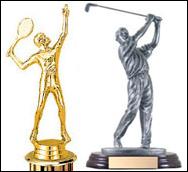
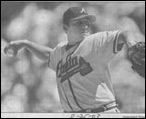 "One year, I saw a photo of myself as a kid trying to look cool on the serve. My pose seemed to resemble the normal "trophy look". Having played a ton of baseball in my youth, I wondered why this strange pose would generate amazing power
"One year, I saw a photo of myself as a kid trying to look cool on the serve. My pose seemed to resemble the normal "trophy look". Having played a ton of baseball in my youth, I wondered why this strange pose would generate amazing power 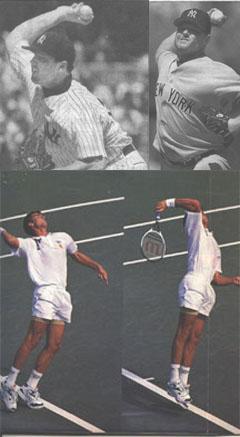 "A baseball pitcher coils his body before throwing. Most tennis players think about the toss before coiling. A baseball player uncoils his body in the same sequence as the tennis server, but there is normally one major difference
"A baseball pitcher coils his body before throwing. Most tennis players think about the toss before coiling. A baseball player uncoils his body in the same sequence as the tennis server, but there is normally one major difference 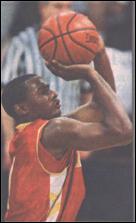
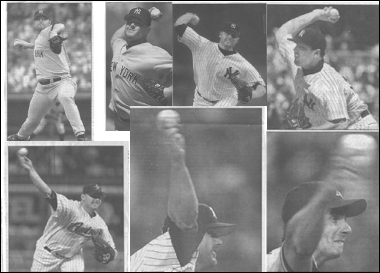 "The elbow of the pitcher's throwing arm points to the batter
"The elbow of the pitcher's throwing arm points to the batter  "A few years ago, Australia's fine tennis researcher, Dr. Bruce Elliott, completed a study on the role of the upper arm (fourth link) and discovered it was responsible for producing 52 percent of the power on the serve. He called the motion the "internal rotation of the upper arm". Critics of the baseball pitching motion
"A few years ago, Australia's fine tennis researcher, Dr. Bruce Elliott, completed a study on the role of the upper arm (fourth link) and discovered it was responsible for producing 52 percent of the power on the serve. He called the motion the "internal rotation of the upper arm". Critics of the baseball pitching motion 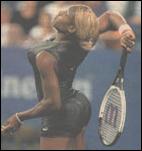
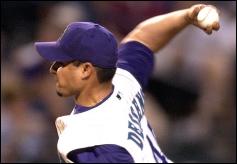 When throwing a ball forward the forearm lays back behind the biceps and "loops" around it. Since the elbow bends and the shoulder rotates internally/externally this is entirely predictable. It is of no surprise on a tennis serve the forearm makes a small backward loop around the biceps on the upward and forward swing. After all, we are not throwing a pencil into the ceiling, or darts.
When throwing a ball forward the forearm lays back behind the biceps and "loops" around it. Since the elbow bends and the shoulder rotates internally/externally this is entirely predictable. It is of no surprise on a tennis serve the forearm makes a small backward loop around the biceps on the upward and forward swing. After all, we are not throwing a pencil into the ceiling, or darts.